FUNDAMENTALS
OF OPTICS FourthEdition
Francis A. Jenkins
Late Professor of Physics
University of California, Berkeley
Harvey E.White
Professor of Physics, Emeritus
Director of the Lawrence Hall of Science, Emeritus
University of California, Berkeley
~
McGraw-Hili Primls
WfiJIiI Custom Publishing
New York Stl.oois SmFzarrisco Auckland Bogota
Caracas
NewDeIhi
lisbon London Madrid Mexia:> Milan Montreal
Pari5 SmJuan Singapore Sydney Tokyo Toronto
�
McGraw-Hill Higher Education ~
A Division of The McGraw-Hill Companies
This book was set in Times Roman. The editors were Robert A. Fry and Anne T.
Vinnicombe;
drawings were done by ANCO Technical Services.
the production supervisor was Dennis J. Conroy. The new
FUNDAMENTALS OF OPTICS Fourth Edition
Copyright@ 2001 by The McGraw-Hill Companies,
Printed in the United States of America. Except as permitted under the United
States Copyright Act of 1976, no part of this publication may be reproduced or
distributed in any form or by any means, or stored in a data base retrieval
system, without prior written permission of the publisher.
Inc. All rights reserved.
This book contains all material from Fundamentals of Optics, Fourth Edition by
Francis A. Jenkins and Harvey E. White. Copyright@1976,
McGraw-Hill Companies,
Fundamentals of Physical Optics. Copyright@ 1937 by The McGraw-Hill
Companies,
White. Reprinted with permission of the publisher.
renewed 1965 by Francis A. Jenkins and Harvey E.
Inc. Copyright
Inc. Formerly published under the title of
1957, 1950 by The
3 4 5 6 7 8 9 0 QSR QSR 0 9 8 7 6 5 4 3 2
ISBN 0-07-256191-2
Editor: Shirley Grall
Printer/Binder: Quebecor World
�
CONTENTS
Preface to the Fourth Edition
Preface to the Third Edition
Part One Geometrical Optics
1 Properties of Light
1.1 The Rectilinear Propagation of Light
1.2 The Speed of Light
1.3 The Speed of Light in Stationary Matter
1.4 The Refractive Index
1.5 Optical Path
1.6 Laws of Reflection and Refraction
1.7 Graphical Construction for Refraction
1.8 The Principle of Reversibility
1.9 Fermat's Principle
1.10 Color Dispersion
xvii
xix
3
5
6
8
9
10
11
13
14
14
18
�
vi
CONTENTS
2 Plane Surfaces and Prisms
2.1 Parallel Beam
2.2 The Critical Angle and Total Reflection
2.3 Plane-Parallel Plate
2.4 Refraction by a Prism
2.5 Minimum Deviation
2.6 Thin Prisms
2.7 Combinations of Thin Prisms
2.8 Graphical Method of Ray Tracing
2.9 Direct-Vision Prisms
2.10 Reflection of Divergent Rays
2.11 Refraction of Divergent Rays
2.12
2.13 Fiber Optics
Images Formed by Paraxial Rays
3 Spherical Surfaces
3.1 Focal Points and Focal Lengths
3.2 Image Formation
3.3 Virtual Images
3.4 Conjugate Points and Planes
3.5 Convention of Signs
3.6 Graphical Constructions. The Parallel-Ray Method
3.7 Oblique-Ray Methods
3.8 Magnification
3.9 Reduced Vergence
3.10 Derivation of the Gaussian Formula
3.11 Nomography
4 Thin Lenses
4.1 Focal Points and Focal Lengths
4.2 Image Formation
4.3 Conjugate Points and Planes
4.4 The Parallel-Ray Method
4.5 The Oblique-Ray Method
4.6 Use of the Lens Formula
4.7 Lateral Magnification
4.8 Virtual Images
4.9 Lens Makers' Formula
4.10 Thin-Lens Combinations
4.11 Object Space and Image Space
4.12 The Power of a Thin Lens
4.13 Thin Lenses in Contact
4.14 Derivation of the Lens Formula
4.15 Derivation of the Lens Makers' Formula
24
24
25
28
29
30
32
32
33
34
36
36
38
40
44
45
46
47
47
50
50
52
54
54
56
57
60
60
62
62
62
63
64
64
65
67
68
70
70
71
72
73
�
5 Thick Lenses
5.1 Two Spherical Surfaces
5.2 The Parallel-Ray Method
5.3 Focal Points and Principal Points
5.4 Conjugate Relations
5.5 The Oblique-Ray Method
5.6 General Thick-Lens Formulas
5.7 Special Thick Lenses
5.8 Nodal Points and Optical Center,
5.9 Other Cardinal Points
5.10 Thin-Lens Combination as a Thick Lens
5.11 Thick-Lens Combinations
5.12 Nodal Slide
6 Spherical Mirrors
6.1 Focal Point and Focal Length
6.2 Graphical Constructions
6.3 Mirror Formulas
6.4 Power of Mirrors
6.5 Thick Mirrors
6.6 Thick-Mirror Formulas
6.7 Other Thick Mirrors
6.8 Spherical Aberration
6.9 Astigmatism
7 The Effects of Stops
7.1 Field Stop and Aperture Stop
7.2 Entrance and Exit Pupils
7.3 Chief Ray
7.4 Front Stop
7.5 Stop between Two Lenses
7.6 Two Lenses with No Stop
7.7 Determination of the Aperture Stop
7.8 Field of View
7.9 Field of a Plane Mirror
7.10 Field of a Convex Mirror
7.11 Field of a Positive Lens
8 Ray Tracing
8.1 Oblique Rays
8.2 Graphical Method for Ray Tracing
8.3 Ray-tracing Formulas
8.4 Sample Ray-tracing Calculations
CONTENTS
vii
78
78
79
81
82
82
84
88
88
90
91
93
93
98
98
99
102
104
105
107
109
109
1I1
115
lIS
1I6
1I7
1I7
1I8
120
121
122
122
124
124
130
130
131
134
135
�
viii
CONTENTS
9 Lens Aberrations
9.1 Expansion of the Sine. First-Order Theory
9.2 Third-Order Theory of Aberrations
9.3 Spherical Aberration of a Single Surface
9.4 Spherical Aberration of a Thin Lens
9.5 Results of Third-Order Theory
9.6 Fifth-Order Spherical Aberration
9.7 Coma
9.8 Aplanatic Points of a Spherical Surface
9.9 Astigmatism
9.10 Curvature of Field
9.11 Distortion
9.12 The Sine Theorem and Abbe's Sine Condition
9.13 Chromatic Aberration
9.14 Separated Doublet
10 Optical
Instruments
10.1 The Human Eye
10.2 Cameras and Photographic Objectives
10.3 Speed of Lenses
10.4 Meniscus Lenses
10.5 Symmetrical Lenses
10.6 Triplet Anastigmats
10.7 Telephoto Lenses
10.8 Magnifiers
10.9 Types of Magnifiers
10.10 Spectacle Lenses
10.11 Microscopes
10.12 Microscope Objectives
10.13 Astronomical Telescopes
10.14 Oculars and Eyepieces
10.15 Huygens Eyepiece
10.16 Ramsden Eyepiece
10.17 Kellner or Achromatized Ramsden Eyepiece
10.18
10.19
10.20 The Kellner-Schmidt Optical System
10.21 Concentric Optical Systems
Special Eyepieces
Prism Binoculars
Part Two Wave Optics
11 Vibrations
and Waves
11.1 Simple Harmonic Motion
11.2 The Theory of Simple Harmonic Motion
11.3 Stretching of a Coiled Spring
11.4 Vibrating Spring
149
150
151
152
153
157
160
162
166
167
170
17l
173
176
182
188
188
191
191
193
193
194
195
195
198
198
200
201
202
205
205
206
206
206
207
208
209
215
216
217
218
221
�
CONTENTS
Ix
11.5 Transverse Waves
11.6 Sine Waves
11.7 Phase Angles
11.8 Phase Velocity and Wave Velocity
11.9 Amplitude and Intensity
11.10 Frequency and Wavelength
11.11 Wave Packets
12 The Superposition of Waves
12.1 Addition of Simple Harmonic Motions along the Same Line
12.2 Vector Addition of Amplitudes
12.3 Superposition of Two Wave Trains of the Same Frequency
12.4 Superposition of Many Waves with Random Phases
12.5 Complex Waves
12.6 Fourier Analysis
12.7 Group Velocity
12.8 Graphical Relation between Wave and Group Velocity
12.9 Addition of Simple Harmonic Motions at Right Angles
13 Interference of Two Beams of Light
13.1 Huygens' Principle
13.2 Young's Experiment
13.3 Interference Fringes from a Double Source
13.4 Intensity Distribution in the Fringe System
13.5 Fresnel's Biprism
13.6 Other Apparatus Depending on Division of the Wave Front
13.7 Coherent Sources
13.8 Division of Amplitude. Michelson Interferometer
13.9 Circular Fringes
13.10 Localized Fringes
13.11 White-Light Fringes
13.12 Visibility of the Fringes
13.13 Interferometric Measurements of Length
13.14 Twyman and Green Interferometer
13.15 Index of Refraction by Interference Methods
14 Interference Involving Multiple Reflections
14.1 Reflection from a Plane-Parallel Film
14.2 Fringes of Equal Inclination
14.3 Interference in the Transmitted Light
14.4 Fringes of Equal Thickness
14.5 Newton's Rings
14.6 Nonreflecting Films
14.7 Sharpness of the Fringes
14.8 Method of Complex Amplitudes
14.9 Derivation of the Intensity Function
223
224
225
228
229
232
235
238
239
240
242
244
246
248
250
252
253
259
260
261
263
265
266
268
270
271
273
275
276
277
279
281
282
286
288
291
292
293
294
295
297
299
300
�
~- --~
X CONTENTS
Fabry-Perot Interferometer
14.10
14.11 Brewster's Fringes
14.12 Chromatic Resolving Power
14.13 Comparison of Wavelengths with the Interferometer
14.14 Study of Hyperfine Structure and of Line Shape
14.15 Other Interference Spectroscopes
14.16 Channeled Spectra.
Interference Filter
15 Fraunhofer Diffraction by a Single Opening
15.1 Fresnel and Fraunhofer Diffraction
15.2 Diffraction by a Single Slit
15.3 Further Investigation of the Single-Slit Diffraction Pattern
15.4 Graphical Treatment of Amplitudes. The Vibration Curve
15.5 Rectangular Aperture
15.6 Resolving Power with a Rectangular Aperture
15.7 Chromatic Resolving Power of a Prism
15.8 Circular Aperture
15.9 Resolving Power of a Telescope
15.10 Resolving Power of a Microscope
15.11 Diffraction Patterns with Sound and Microwaves
16 The Double Slit
16.1 Qualitative Aspects of the Pattern
16.2 Derivation of the Equation for the Intensity
16.3 Comparison of the Single-Slit and Double-Slit Patterns
16.4 Distinction between Interference and Diffraction
16.5 Position of the Maxima and Minima. Missing Orders
16.6 Vibration Curve
16.7 Effect of Finite Width of Source Slit
16.8 Michelson's Stellar Interferometer
16.9 Correlation Interferometer
16.10 Wide-Angle Interference
17 The Diffraction Grating
17.1 Effect of Increasing the Number of Slits
17.2 Intensity Distribution from an Ideal Grating
17.3 Principal Maxima
17.4 Minima and Secondary Maxima
17.5 Formation of Spectra by a Grating
17.6 Dispersion
17.7 Overlapping of Orders
17.8 Width of the Principal Maxima
17.9 Resolving Power
17.10 Vibration Curve
17.11 Production of Ruled Gratings
17.12 Ghosts
301
302
303
305
308
310
311
315
315
316
319
322
324
325
327
329
330
332
334
338
338
339
341
341
342
346
347
349
351
352
355
355
357
358
358
359
362
362
363
364
365
368
370
�
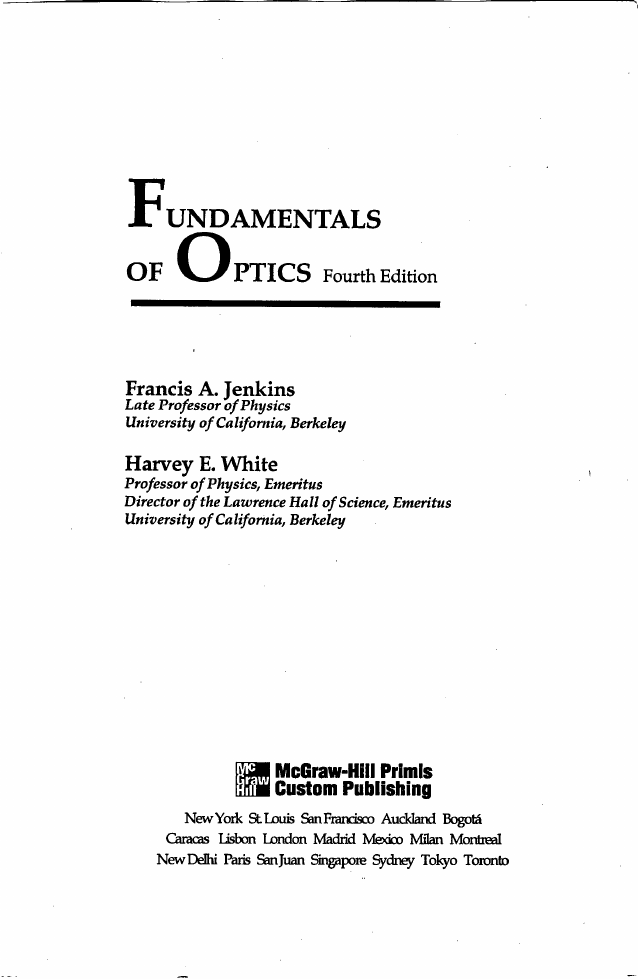
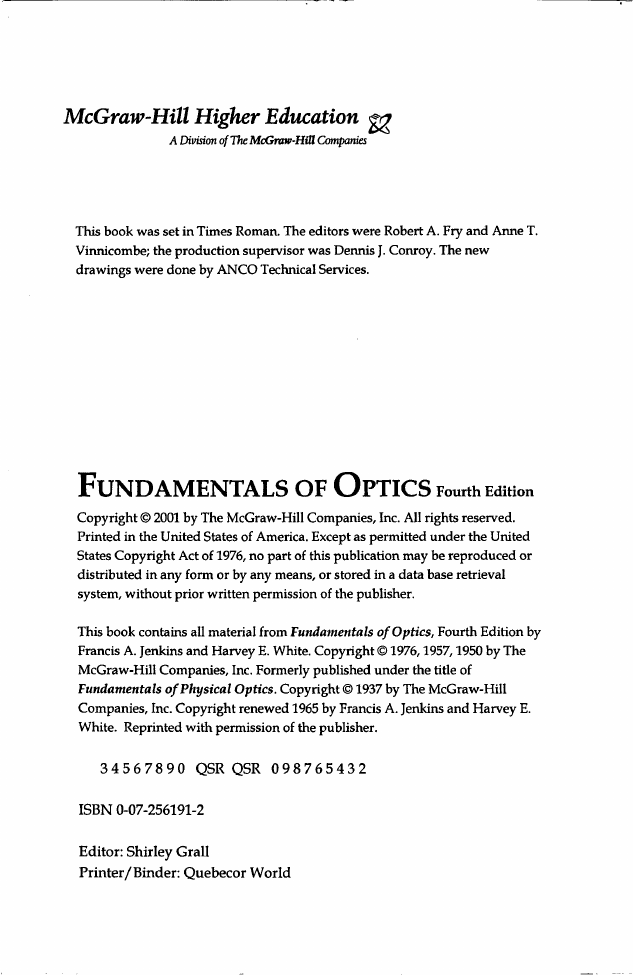
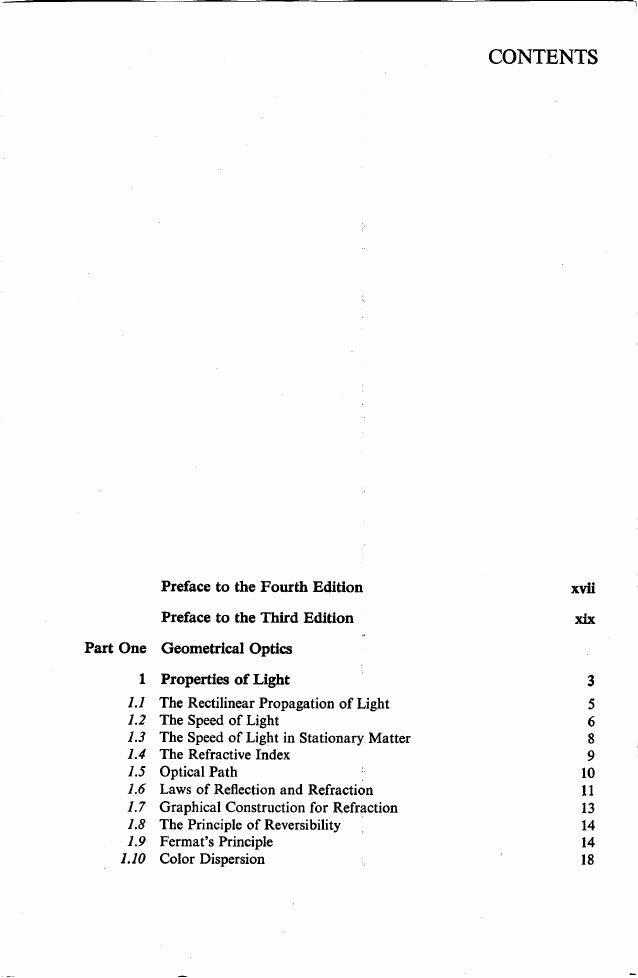
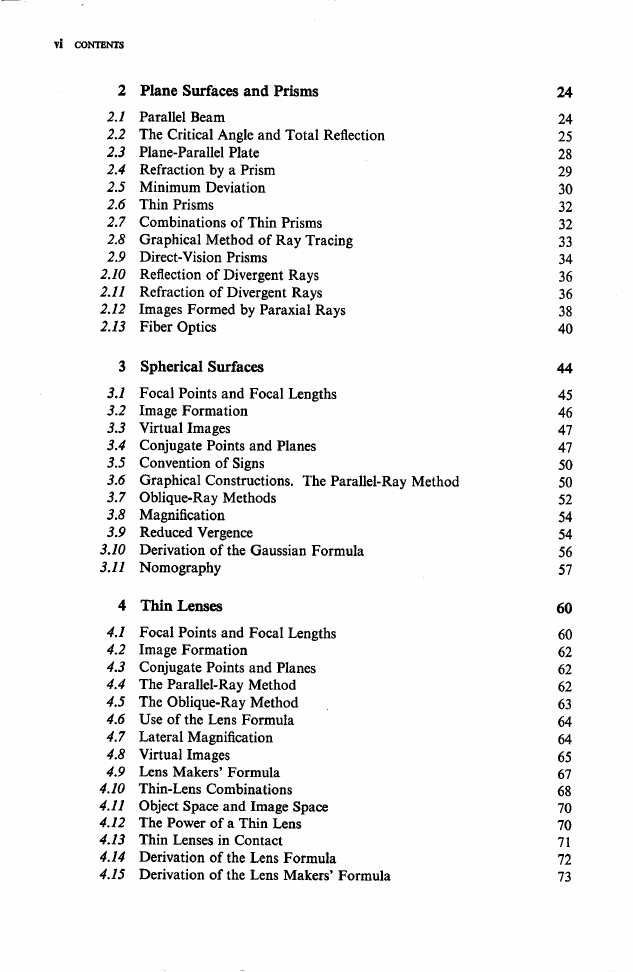
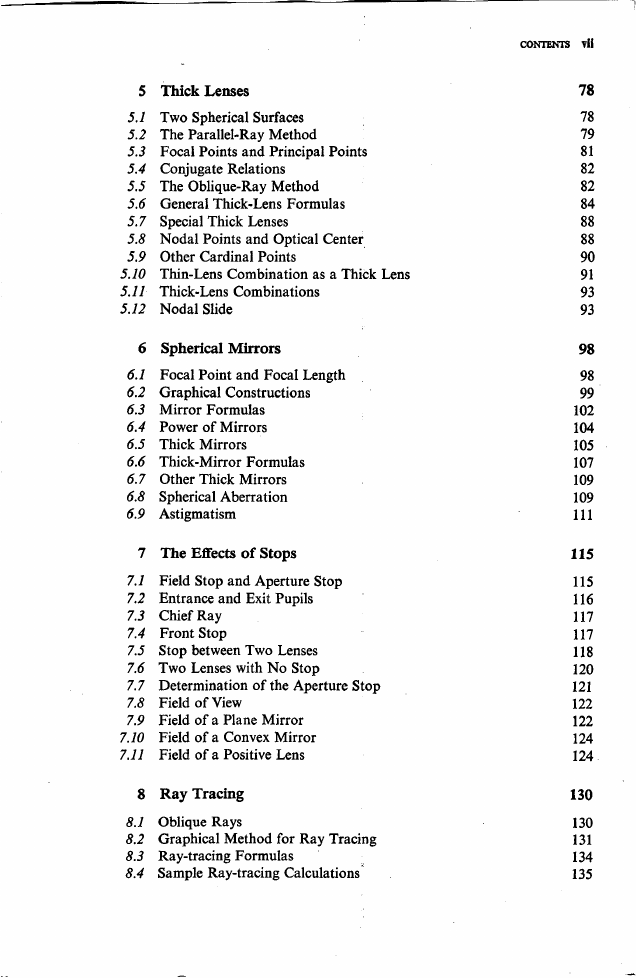
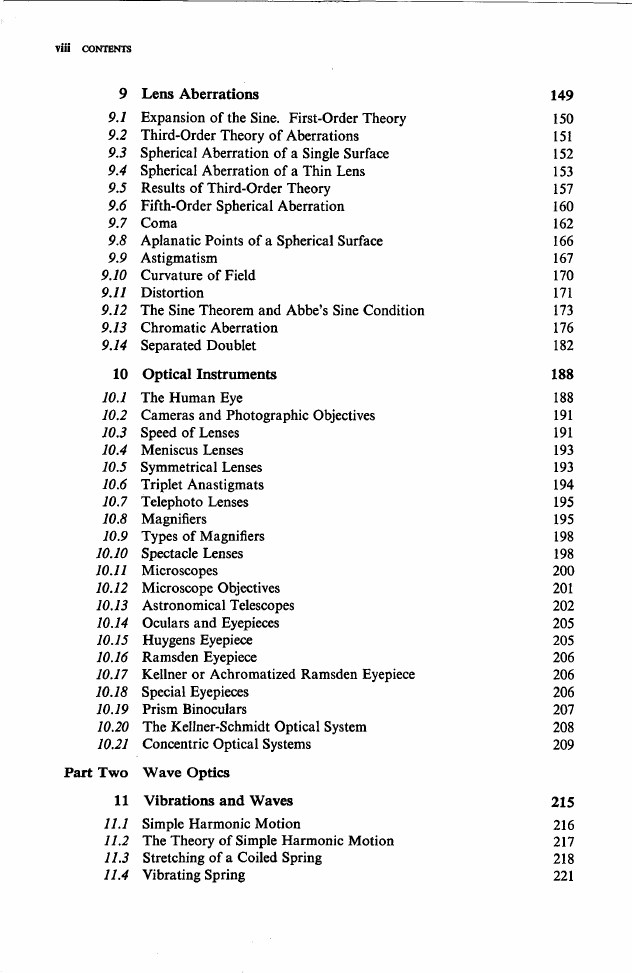

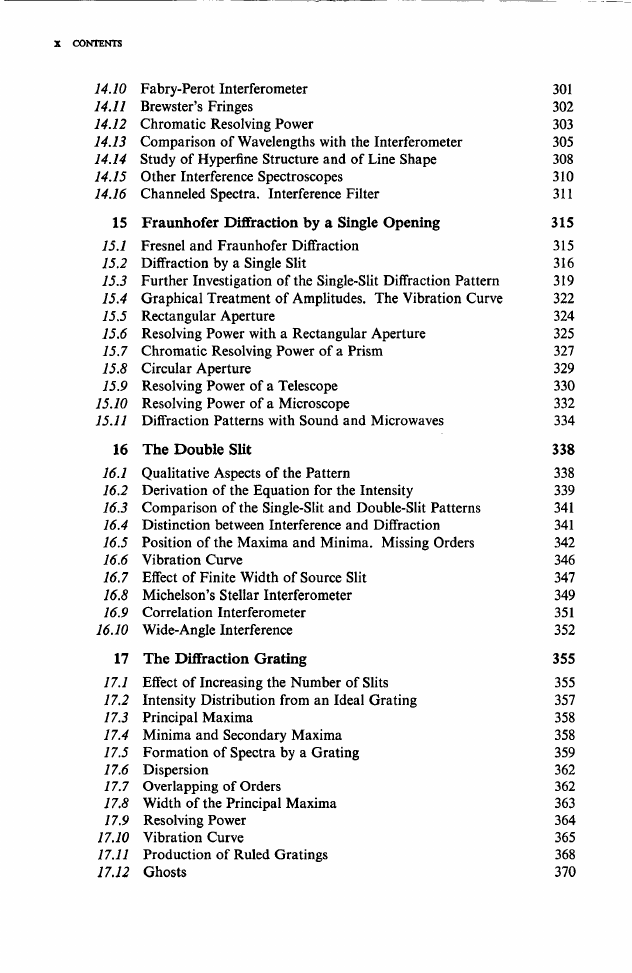








 2023年江西萍乡中考道德与法治真题及答案.doc
2023年江西萍乡中考道德与法治真题及答案.doc 2012年重庆南川中考生物真题及答案.doc
2012年重庆南川中考生物真题及答案.doc 2013年江西师范大学地理学综合及文艺理论基础考研真题.doc
2013年江西师范大学地理学综合及文艺理论基础考研真题.doc 2020年四川甘孜小升初语文真题及答案I卷.doc
2020年四川甘孜小升初语文真题及答案I卷.doc 2020年注册岩土工程师专业基础考试真题及答案.doc
2020年注册岩土工程师专业基础考试真题及答案.doc 2023-2024学年福建省厦门市九年级上学期数学月考试题及答案.doc
2023-2024学年福建省厦门市九年级上学期数学月考试题及答案.doc 2021-2022学年辽宁省沈阳市大东区九年级上学期语文期末试题及答案.doc
2021-2022学年辽宁省沈阳市大东区九年级上学期语文期末试题及答案.doc 2022-2023学年北京东城区初三第一学期物理期末试卷及答案.doc
2022-2023学年北京东城区初三第一学期物理期末试卷及答案.doc 2018上半年江西教师资格初中地理学科知识与教学能力真题及答案.doc
2018上半年江西教师资格初中地理学科知识与教学能力真题及答案.doc 2012年河北国家公务员申论考试真题及答案-省级.doc
2012年河北国家公务员申论考试真题及答案-省级.doc 2020-2021学年江苏省扬州市江都区邵樊片九年级上学期数学第一次质量检测试题及答案.doc
2020-2021学年江苏省扬州市江都区邵樊片九年级上学期数学第一次质量检测试题及答案.doc 2022下半年黑龙江教师资格证中学综合素质真题及答案.doc
2022下半年黑龙江教师资格证中学综合素质真题及答案.doc